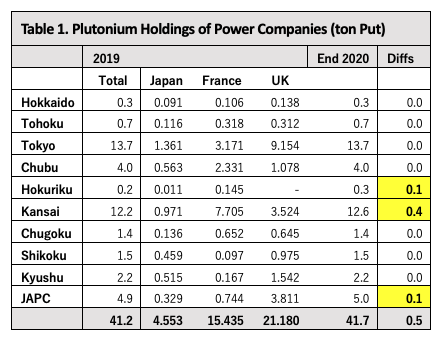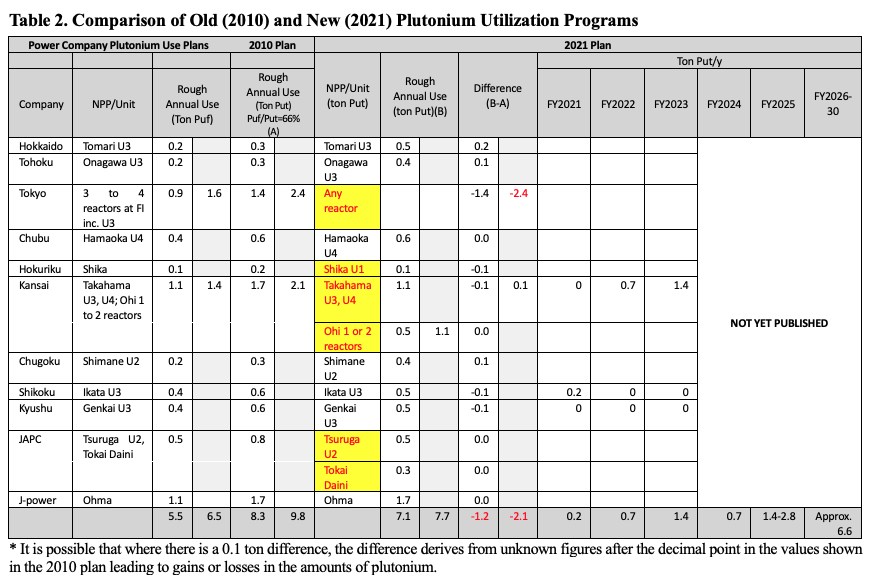Put New Wine in New Wineskins
The New Plutonium Utilization Plan will Inevitably Fail
By Matsukubo Hajime (CNIC)
From the very early days of nuclear development, Japan made the decision to reprocess all spent nuclear fuel and use the extracted plutonium in fast breeder reactors. However, as the development of fast breeder reactors ground to a halt, the government changed its policy to mix plutonium with uranium and use it in ordinary nuclear reactors.
There are two reprocessing facilities in Japan. One is the Tokai Reprocessing Plant (now closed) in Ibaraki Prefecture, and the other is the Rokkasho Reprocessing Plant, now under construction in Aomori Prefecture. The spent fuel produced by electric power companies is to be reprocessed mainly at the Rokkasho Reprocessing Plant. The plant is scheduled to reprocess 800 tons of spent fuel annually, resulting in about 8 tons of plutonium. In 1997, when the Rokkasho Reprocessing Plant was supposed to have been completed, the utility announced its first plutonium utilization plan indicating how the 8 tons of separated plutonium would be used. According to the plan, it was to be arranged for 16 to 18 nuclear reactors to use mixed plutonium and uranium MOX fuel to consume 7 to 11 tons of plutonium annually by 2010. As of 2011, however, due to multiple delays in the plan, only 4 nuclear reactors, Genkai Unit 3, Ikata Unit 3, Fukushima Daiichi Unit 3 and Takahama Unit 3, were equipped with the ability to use MOX fuel.
The construction of the Rokkasho Reprocessing Plant was also significantly delayed during the 2010s, and the 2010 plutonium utilization plan was not revised. However, with the completion of the Rokkasho Reprocessing Plant now planned for the first half of FY2022, the Federation of Electric Power Companies of Japan (FEPC) announced, on February 26 this year, plutonium holdings as of the end of 2020 as well as plans to use the new plutonium.
Power Companies’ Plutonium Stocks
First, let’s take a look at plutonium stocks (Table 1). At the end of 2019, the amount of plutonium held by power companies was 41.2 tons, but by the end of 2020, it had increased to 41.7 tons, an increase of 0.5 tons. No reprocessing is currently conducted in Japan, but reprocessing was previously commissioned to the United Kingdom and France. Both have completed the reprocessing itself, but there was an increase in the amount of plutonium due to administrative allocations in the UK. Further, of the total 41.2 tons of plutonium held in 2019, 15.4 tons were located in France and 21.2 tons in the UK.
In addition, Japan Atomic Energy Agency held 4,641 kg of plutonium as of the end of 2019. While the year differs, the total comes to 46.3 tons.
Plutonium Utilization Program
Before unraveling the plutonium utilization plan, I need to explain a little about plutonium. When uranium fuel is burned in a nuclear reactor, uranium-235, 3 to 5% of uranium fuel, is struck by the neutrons flying around in the reactor and undergoes nuclear fission. Uranium-238, 95 to 97% of uranium fuel, sometimes absorbs neutrons to become plutonium-238. The plutonium-238 thus produced absorbs more neutrons to produce plutonium-239, 240 and 241. Spent fuel contains around 1% of uranium-235 that did not undergo nuclear fission, 93 to 95% of uranium-238, 1% of various plutonium nuclides, and 3 to 5% of fissile materials such as iodine, cesium, and strontium, released in large quantities during the Fukushima Daiichi Nuclear Power Station accident.
Governments and power companies often use plutonium quantities focused on fissile plutonium-239 and 241. This is expressed by the symbol “Puf” (Pu for the element plutonium followed by an “f” for “fissile”). It is explained that nuclear power plants generally only fission fissile plutonium, which cannot be used as a resource. However, even plutonium which is difficult to use in nuclear reactors can be fissioned with high-energy fast neutrons. For example, fast breeder reactors can use all forms of plutonium as fuel, and nuclear weapons can use all forms of plutonium as energy to produce an explosion. Therefore, for nuclear nonproliferation purposes, there is no distinction between fissile and non-fissile plutonium, and all forms of plutonium are treated as equally dangerous. The symbol used for this is Put or Putot (using the “t” or “tot” of “total”).
Further, in the past, the maximum plutonium separation capacity of the Rokkasho Reprocessing Plant was said to be 8 tons/year, but this has been reduced to 6.6 tons in recent explanations. (For example, according to an explanation by the Ministry of Economy, Trade and Industry at a meeting of the special committee investigating nuclear issues in the lower house of the Japanese Diet on May 19, 2020.) On the other hand, the Rokkasho Reprocessing Plant’s application states that an annual 7 tons of plutonium will be separated.
Will this plan work? When you look at the names of the nuclear power plants that are lined up in Table 2, not only are many of them unable to restart operations, many are far from passing the new regulatory standards. The Atomic Energy Commission is committed to the operation of the Rokkasho Reprocessing Plant based on this pie in the sky. Japan currently holds 46 tons of plutonium. Shouldn’t we first be considering what to do with this plutonium?
The situation has changed greatly in the last 20 years, but the plutonium program has shown no change at all. If the Rokkasho Reprocessing Plant begins operations and the amount of plutonium Japan holds increases, however, Japan will simply face more issues that will need to be addressed. Just somehow adjusting the old plan to fit the new circumstances, will obviously result in failure.


